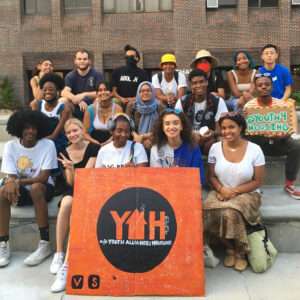
The Youth Alliance for Housing is a New York City-based collective of young people fighting to radically transform the housing system in the United States. While most efforts to tackle the nationwide housing affordability crisis are focused on fighting for policy reforms to regulate our market-based system or seek government interventions to increase the housing supply, YAH is trying to shift the paradigm of housing justice altogether.
For these youth organizers, the housing crisis can’t be solved by policy alone. In addition to building collective power together, they are cultural organizers, seeking to build strong, interdependent communities where housing is no longer a profit-making commodity, where houselessness does not exist, where all are guaranteed a decent, safe, affordable home.
Emma Rehac is one of the founders of the collective. Currently a university student, she is a transracial adoptee, raised by a white immigrant single mother in New York City.
“I have felt the deep impacts of red-lining, rising rent, and gentrification,” she says. “I have lived in buildings with sewage issues, places with mold in the walls, apartments that would get freezing cold in the winter and sweltering hot in the summer. But for me, housing justice is about so much more than just affordability and living conditions. Growing up I never wanted to go home, I would sign up for every extracurricular activity I could. I didn’t feel safe at home, I didn’t feel safe at school, and I often felt so trapped.”
It was in this context of insecurity and stress, combined with the relationships she formed in her community with people who shared the same struggle, that shaped her to be the organizer she is today, starting when she was fourteen. Her personal experience of housing insecurity led to a somewhat different definition of what it means to be a “tenant,” one couched in a broader, intersectional framework of youth liberation.
“A tenant is anyone who doesn’t have full control of their housing,” she explains. “We want young people to see themselves as tenants. When you are afraid to go home, that is housing injustice.”
It is a definition that encompasses everyone who is dependent on someone else for shelter. In other words, children. The definition might be uncomfortable or surprising to someone who experienced relative safety in their childhood home, or who accept the givenness of adult power, but for young people who experience home as a lack of safety, the precarity and vulnerability inherent to being dependent on someone with absolute power over your life circumstances comes into sharp focus. YAH’s analysis indicts the state, which often criminalizes youth for seeking supportive survival resources outside of their households when their households become unsafe.
For Emma, and for YAH more broadly, powerful tenant organizing must therefore address ageism and fight for the bodily autonomy of children. It must center youth of all races, classes, and genders as directly affected people on the front lines of the housing crisis. It must understand that the regime of private property rooted in the genocidal theft of Indigenous land lies at the root of the housing issue.
As cultural organizers, YAH focusses on creating structures of collective care that become a political home for their peers. It looks like providing spaces where people can talk and work on trauma healing. It looks like establishing mutual aid networks to meet basic needs. It looks like regular community gatherings where people can share resources, raise funds, and have fun.
When Emma dreams of the future she wants, she envisions an abandoned mansion. “I want to reclaim abandoned space!” she says. “I want to take over a big mansion and live there in community with others.” It is a vision of shelter and safety that transcends the nuclear family. It is a vision of true interdependence, where all have what we need and none have to be afraid.




